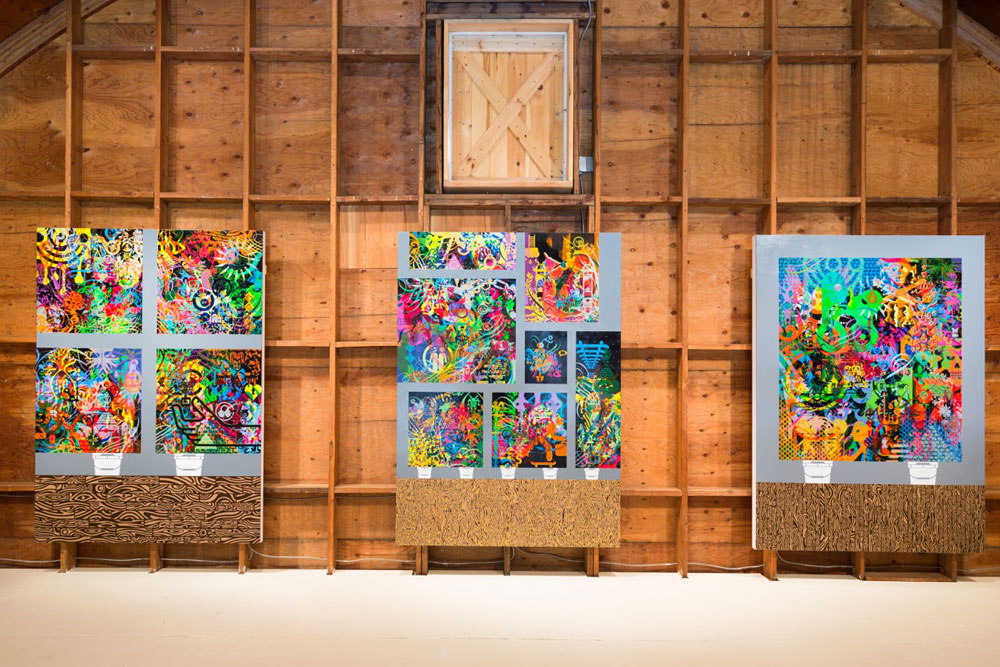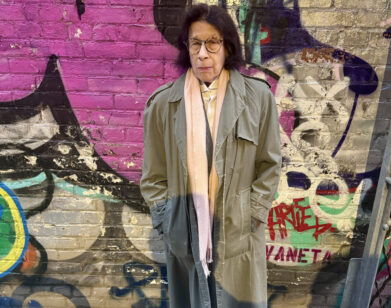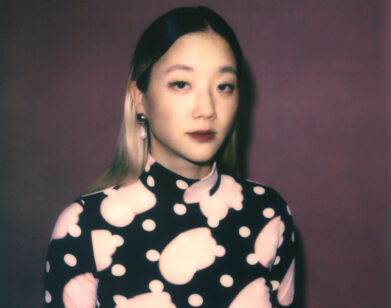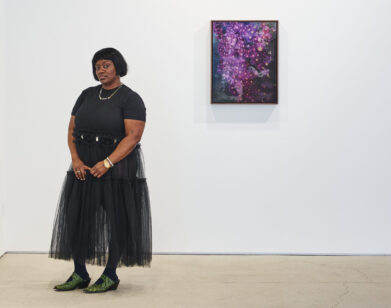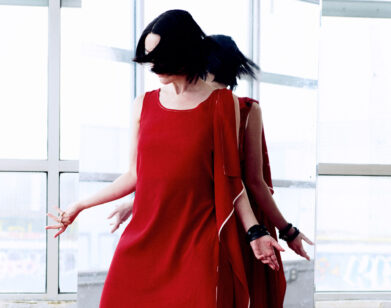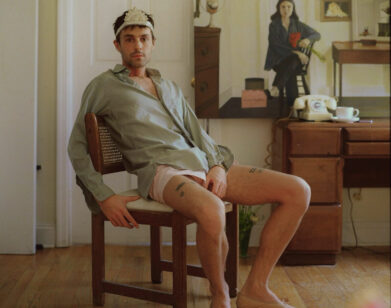Signs of Ryan McGinness
Last summer over the course of a single week, 50 signs desinged by Ryan McGinness were placed on roadside poles throughout Manhattan. Each sign featured symbols from the New York-based artist’s imagination for passersby to interpret and personalize. A year later, the Virginia Beach native has developed one of his most ambitious projects to date: “Sign Trees.” The name of both the new series and an exhibition currently on view at Silas Marder in Bridgehampton, “Sign Trees” consists of just what one might expect: signs, similar to those placed around the City, attached to life-size metal trunks and branches.
While reproductions of his Sign Trees can be seen in the slideshow above, McGinness creates custom paints that does not fully translate in RGB, the color format of which jpegs are composed. To experience his works’ strongest effects, it must be seen in person.
McGinness’ childhood, which was spent immersed within skate and surf culture, and interest in contemporary consumer culture are seen through the 43-year-old’s consistent use of symbolism and fluorescent paint (such as in his “Blackholes” series), creation of public art, and ability to engage viewers. We met the artist earlier this summer in downtown Manhattan, but spoke again over the phone, closer to his completion of “Sign Trees.”
EMILY MCDERMOTT: We met at your studio a few weeks ago, but it’s always nice to have follow-up conversations.
RYAN MCGINNESS: And now is a perfect time. I am actually down in Virginia, in Gloucester on the Chesapeake Bay, which means I’m more relaxed than being in New York in the studio.
MCDERMOTT: I want to talk about “Sign Trees.” It’s an expansion of the street signs you did in New York last year, right?
MCGINNESS: You’re absolutely right. Not only did I make a series of signs and have them installed throughout Manhattan last year, but it’s a continuation of an interest in signage that I’ve been exploring in general—not only the forms and the materials of street signs, but also the visual language. “Sign Trees” is the first time I’m making a structure with multiple signs on it. I used the word “tree” because they take the same structure. They have a main trunk, branches that come off, and then off of each branch is a sign, or a big leaf. So they are natural and organic, but also very synthetic. They look like they could fit in an urban landscape: sign posts that are just saturated with signs, like in Times Square. That will actually be the next location for these Sign Trees; they’re going to be installed in Times Square in the spring. They depict, like a lot of my work, surreal and absurd imagery.
MCDERMOTT: How did you decide to use trees as the structural form?
MCGINNESS: It started with just looking at the urban environment and seeing signposts and lampposts and how those were becoming saturated with signage. They look like trees to me, basically. [laughs] It just makes sense visually.
MCDERMOTT: Your work deals a lot with public and private, in the sense that the narratives are very private—they’re your own stories—but as a whole reference public signage. How do you think about public versus private when creating work?
MCGINNESS: There’s a real dichotomy. Sharing the work publicly, but sharing these personal and almost cryptic images that are very private narratives—I think that’s always been the premise of art. There’s a whole range of sources of inspiration for the drawings and stories. They come from dreams, hallucinations, pop songs, or other things I see in the world around me.
MCDERMOTT: Within the new series, there are paintings of other paintings. Can you talk about this aesthetic?
MCGINNESS: The work recently has taken a turn to be kind of more about the work, and be a meditative series. So the paintings within the paintings are actually studio views, where the paintings are sitting on paint buckets and you see the studio floor below, which is the wood grain. It’s the result of the work folding in on itself, so now the work is the subject.
For me, this forces the contemplation of the work. If you have a painting that’s more what I would call a full-bleed—the images kind of go off on all sides, but then you locate that within another painting, then you have this compositional frame around it—then it forces the painting to become foreground. In doing so, it forces a more considered look. But those paintings within paintings are just a small part of the larger body of work, which also includes some of the screens, and other tools that I’ve used. There are screens, squeegees, wigs of my own hair… I’ve been letting my hair grow for 18 months, going to a wig maker and cutting it off, and then making wigs of my own hair. I’ve made three of those. I think I’m going to stop and just have that be the work.
MCDERMOTT: What was the inspiration behind that? I had no idea you were doing it…
MCGINNESS: Warhol’s “Fright Wigs,” which were always kind of part of a costume, and I wanted to make something more genuine and real, which of course is my own real hair. It’s obviously about the identity of the artist, and this idea of the residue and the tools becoming part of the work.
MCDERMOTT: I want to ask about a few of the recurring symbols that are very prominent in all of your works. Those, to me, seem to be eyes, wings, and birds. Do they have any specific meaning for you?
MCGINNESS: Those tend to pop up more and more. The eyes are more of a psychedelic vision—the exploding eyes. Obviously the birds and flight have more to do with freedom, but you’re right, that’s reoccurring subject matter, eyes maybe more than anything.
MCDERMOTT: Those have been present since the beginning, right?
MCGINNESS: I guess so, depending on what you’d consider the beginning. [laughs] Symbols fade away, and some drawings continue getting thrown into the mix, and, as far as subject matter goes, I’ll expand upon some themes. Eyes have stuck around for a while.
MCDERMOTT: You make all of your own paints, and there are many fluorescents that don’t really translate in photographs. How do you feel about printed reproductions of your work?
MCGINNESS: That’s exactly my reason [for making my own paint]: to force a real-time experience of the work. Most work today is experienced by reproduction, and more specifically by computer screen, like jpegs, but an RGB simulation of fluorescent will never fully accurately depict that color. So reproductions will always fall short of experiencing the work in person. I’ve even talked about going so far as to include captions of the work within the paintings, or screen symbols within paintings, like a little “X” in the top-right corner, so that when you see a reproduction you might think you could close that jpeg or image of the painting by clicking on the painting. That’s why I include these superfluous crop marks in paintings and absurd registration marks, in order to force a contemplation of the fact that you’re looking at a reproduction.
[In person,] the work’s completely different, not only because of the scale shift, but color, as you mentioned. Our eyes are a lot more sophisticated than you might assume. You can feel a lot more going on on the surface of a canvas than you can on the surface of a screen.
MCDERMOTT: On separate note, what do you do in your downtime to decompress, when you’re not in the studio?
MCGINNESS: Now’s the perfect time to ask that question because I really don’t take so-called “vacations” that often. In fact vacations are more stressful than the lives my wife and I worked hard to set up for ourselves in New York. It seems like being on vacation is like normal living, which is not very satisfying. It means we’re figuring out what to make for lunch today, and that seems like such an absurd way to live. The issue of dealing with that doesn’t seem to be so prominent back home. It sounds so silly and ridiculous, but it’s really the way it is. We love what we do, so I prefer being in the studio; that’s really living for me.
Having said all that, we’ve tried to make this so-called vacation more productive. We’ve set up a home office, and I have a drawing area on the porch here, so I’m able to work on a lot of drawings. But to more succinctly answer your question, I’d say drawing. I love drawing, whether it’s considered work or not, but I’m always drawing, and that’s the core of the work. Everything comes from drawing.
MCDERMOTT: Whether it’s for a singular piece, the upcoming show, or even the Hennessy label, what are some recent things that have really inspired you? Aside from street signs and trees, of course.
MCGINNESS: I’m working on a mother and child serious right now, which are obviously inspired by my wife and two little girls. That’s something I’ve been concentrating on out here: just drawing the girls.
MCDERMOTT: Are those going to be as abstract and filled with various symbols, or are they going to be more figurative?
MCGINNESS: Let’s say abstract figures. They are more like an extension of the figurative body of work, which are all based from life figure drawings. If I had to organize some of my different bodies of work, I would say “Mindscapes,” out of which “Sign Trees” is developing, and “Figures,” out of which “Mother and Child” is developing, and we have “Blackholes,” out of which the Hennessy label developed. So, for example, on the label, you see one centered black hole in different fluorescents, which comes back to the idea of forcing a real space-time consideration of the label and of Hennessy. It’s something you have to experience it in real life; you can’t experience it in any other way, and shouldn’t.
MCDERMOTT: Obviously a lot of your works change when you put them under black lights. When you make a work, how do you think about light? Do you think from the beginning, “This is going to be shown under a black light”?
MCGINNESS: It is usually a preconceived consideration, and it’s usually with a site or a specific location in mind, and it’s usually within a museum or a gallery, where I can control the parameters. But sometimes it’s within parameters I can’t control. Regardless, the paintings themselves are always considered beforehand to be shown under black light.
MCDERMOTT: Do you ever actually paint under black lights?
MCGINNESS: Only for very short periods, only for checking. We have LED black light flashlights, which are effective tools for checking the progress of paintings.
MCDERMOTT: Throughout your 15 to 20 years as an artist, what’s a struggle you continue to face?
MCGINNESS: The biggest struggle is simply finding time to work. There’s a huge difference between doing what you love as a hobby and doing something professionally. So it’s still a struggle just to find time to work, and be alone, and concentrate on the work, because those activities are at odds with running the studio—two very different activities.
Another struggle has been to locate very accurately where I am in the work and concentrate on that. What that means, is to figure out the most important contribution I can make to the work. For some artists it’s simply art direction; for other artists it’s locating themselves in the beginning of a project and then stepping away; for me it’s all about drawing, so it’s very important to find time and make time to get away and just concentrate on the drawings. Those are the core ingredients for all the work. It’s been a struggle to figure that out. This idea of getting away and being alone and allowed to be in my own head is very useful and productive.
“RYAN MCGINNESS: SIGN TREES” IS ON VIEW AT SILAS MARDER THROUGH AUGUST 29. FOR MORE ON THE ARTIST, VISIT HIS WEBSITE.

